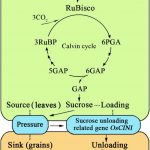Circadian Clock Gene Affects Aphid Feeding
Phloem sap-feeding aphids inflict plant damage by direct feeding and by acting as a vector for plant disease transmission. Their highly  specialized stylets reach the phloem sieve elements, allowing aphids to extract plant photoassimilates without consuming structural tissues. Probing and feeding by aphids elicits plant defense responses, leading to retarded aphid development, reduced aphid survival and reproduction (antibiosis), and/or nonpreference (antixenosis). Studies on plant defense against aphids have revealed the involvement of signal transduction mediated by phytohormones including jasmonic acid (JA). CIRCADIAN CLOCK-ASSOCIATED1 (CCA1) is a central circadian clock regulator whose daily rhythmic expression in Arabidopsis (Arabidopsis thaliana) confers host resistance to the caterpillar Trichoplusia ni by synchronizing JA-mediated defenses with the insect’s circadian feeding behavior. Lei et al. (10.1104/pp.19.00676) now examine the question of whether CCA1 also plays a role in plant defense against phloem sap-feeding green peach aphids (Myzus persicae). Whereas several loss-of-function clock mutants were more susceptible to aphid infestation than WT, arrhythmic CCA1-OX exhibited enhanced resistance and showed stronger antibiotic and antixenotic activities toward aphids. Aphids feeding on CCA1-OX plants exhibited lower reproduction and smaller body size and weight than those on WT. Constitutive activation of CCA1 seemed to positively regulate the biosynthesis of indoleglucosinolates, which are secondary metabolites with demonstrated anti-aphid activity. In addition, aphid infestation modulated CCA1 alternative splicing, as evidenced by increased transcript abundance of intron-retaining CCA1 mRNA variants.
specialized stylets reach the phloem sieve elements, allowing aphids to extract plant photoassimilates without consuming structural tissues. Probing and feeding by aphids elicits plant defense responses, leading to retarded aphid development, reduced aphid survival and reproduction (antibiosis), and/or nonpreference (antixenosis). Studies on plant defense against aphids have revealed the involvement of signal transduction mediated by phytohormones including jasmonic acid (JA). CIRCADIAN CLOCK-ASSOCIATED1 (CCA1) is a central circadian clock regulator whose daily rhythmic expression in Arabidopsis (Arabidopsis thaliana) confers host resistance to the caterpillar Trichoplusia ni by synchronizing JA-mediated defenses with the insect’s circadian feeding behavior. Lei et al. (10.1104/pp.19.00676) now examine the question of whether CCA1 also plays a role in plant defense against phloem sap-feeding green peach aphids (Myzus persicae). Whereas several loss-of-function clock mutants were more susceptible to aphid infestation than WT, arrhythmic CCA1-OX exhibited enhanced resistance and showed stronger antibiotic and antixenotic activities toward aphids. Aphids feeding on CCA1-OX plants exhibited lower reproduction and smaller body size and weight than those on WT. Constitutive activation of CCA1 seemed to positively regulate the biosynthesis of indoleglucosinolates, which are secondary metabolites with demonstrated anti-aphid activity. In addition, aphid infestation modulated CCA1 alternative splicing, as evidenced by increased transcript abundance of intron-retaining CCA1 mRNA variants.



